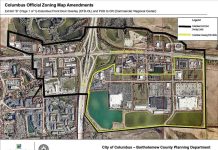The number of train-horn blasts being heard in Columbus is providing a loud signal of increased rail traffic on the Louisville & Indiana tracks.
“We haven’t received any complaints about the amount of train traffic going through the city yet,” said Columbus Mayor Jim Lienhoop. “But we are getting complaints about the number of train horns.”
In a Monday ribbon-cutting ceremony on the new railroad bridge, Louisville & Indiana President John Goldman thanked the city for its cooperation during the bridge construction, which completes more than $12 million in improvements in the rail line through Columbus.
The city announced last month that it had been notified that a long-predicted increase in the number of longer, faster trains would begin in early November, with city officials cautioning motorists to be careful and patient as the city works to build a way over the tracks on the city’s west side.
[sc:text-divider text-divider-title=”Story continues below gallery” ]Click here to purchase photos from this gallery
Columbus and INDOT are building the overpass over the State Road 46/State Road 11 train crossing, in partnership with the Louisville & Indiana Railroad, as a way for west-side traffic to enter and leave the city without delays.
Last year, Columbus approved the creation of a non-reverting fund to pay for the overpass, allowing the city to keep track of money toward the project at the State Road 46/State Road 11 intersection. The state has agreed to pick up $15 million, half of the project’s overall cost, while the city’s portion will come from different private and public sources of funding.
A study commissioned by the city indicated that as many as 22 trains a day could begin traveling through the State Road 46 intersection compared to eight before. And the trains’ length will be longer, from 5,100 feet before to 7,500 feet in the future.
The increased number of trains has been audible so far because train engineers are following the rules to the letter when to traveling through Columbus’ four railroad crossings downtown, the mayor said. At each of the crossings, at State Road 46/State Road 11, and at Fifth, Eighth and 11th streets, train engineers are sounding four warnings — two long horn bursts, one short, and then one long.
“If you think about it, with the four crossings, that’s 16 horn soundings per train,” Lienhoop said during an interview this week in his office, as a train horn was audible inside City Hall several blocks away. “And that’s any time of the day or night.”
The city has been working with a Texas company, CTC of Fort Worth, which had been recommended by the Louisville & Indiana Railroad, to assist the city with planning for needed infrastructure to establish a quiet zone through the four intersections, so the horns would not have to be sounded. CTC has completed more than 100 quiet zones so far for other communities, city redevelopment director Heather Pope said.
The city would have to place gates at all the crossings in the quiet zones and make modifications to the crossings to prevent vehicles from passing through the intersection when a train is approaching.
The city would be required to pay for the safety improvements, which Redevelopment Commission member John Dorenbusch said in an earlier meeting that he had heard could reach $250,000, on top of the $41,000 for the CTC contract.
As that work continues, Goldman issued a Nov. 2 notification giving the city 30 days notice that the freight trains traveling on the rail line would see an increase in train speed, frequency and length.
In a telephone interview, he confirmed that CSX and Louisville & Indiana could begin with the increased frequency at any time leading up to the end of the 30-day notice, which is given as Dec. 4.
With all signage in place, Goldman said CSX can begin running as many trains as it wishes.
With the completion of the bridge, Goldman said Louisville & Indiana workers are continuing to clean up the temporary construction site and removing equipment from the Noblitt Park area, where the bridge is located. The rail company is replacing trees that were removed from the site, including 365 in new planting with the help of the Columbus Parks Department.
A U.S. Department of Transportation Surface Transportation Board decision in April 2014 approved a request by CSX Railroad for joint use of the Louisville & Indiana Railroad’s 106-mile rail corridor between Louisville, Kentucky and Indianapolis. Since then, the two railroad companies have completed upgrades for high-speed rail between Louisville and Indianapolis, including completing the new Noblitt Park railroad bridge over the Flatrock River in Columbus, which was the final phase for the work. The work replaced a bridge that had spanned the river near downtown Columbus for more than 100 years.
The work in its entirety along the rail line represented a $100 million investment by CSX to the tracks, bridges and signals along the entire rail line, Goldman said.
The improvements will increase efficiency and safety along the corridor between the important consumer and freight hubs of Louisville and Indianapolis, he said.




